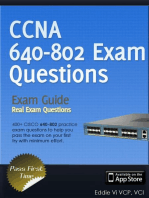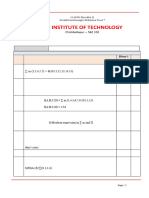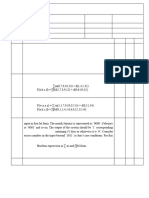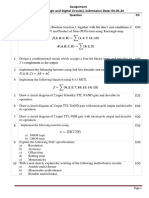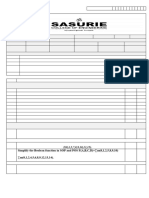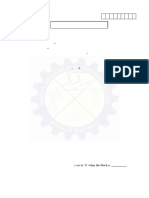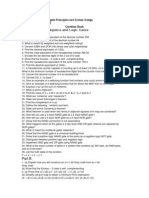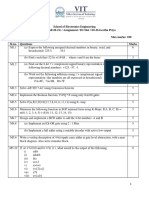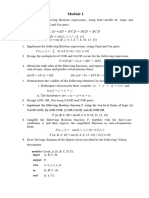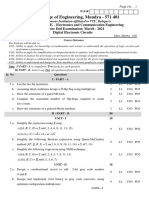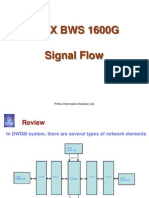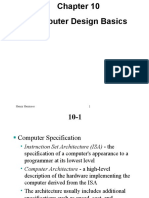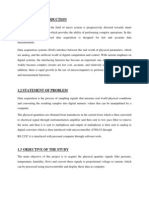DD&CO Model Set1 Paper 2022 Scheme
DD&CO Model Set1 Paper 2022 Scheme
Uploaded by
anveshrao024Copyright:
Available Formats
DD&CO Model Set1 Paper 2022 Scheme
DD&CO Model Set1 Paper 2022 Scheme
Uploaded by
anveshrao024Original Description:
Original Title
Copyright
Available Formats
Share this document
Did you find this document useful?
Is this content inappropriate?
Copyright:
Available Formats
DD&CO Model Set1 Paper 2022 Scheme
DD&CO Model Set1 Paper 2022 Scheme
Uploaded by
anveshrao024Copyright:
Available Formats
Model Question Paper- I with effect from 2022
Third Semester B.E Degree Examination
Digital Design and Computer Organization (BCS302)
TIME: 03 Hours Max.Marks:100
1. Note: Answer any FIVE full questions, choosing at least ONE question from each MODULE
2. M: Marks, L: Bloom’s level, C: Course outcomes.
Module - 1 M L C
Q.1 a Demonstrate the positive and negative logic using AND gate 5 L1 CO1
b Find the POS expression for F(a,b,c,d) = Π(2,3,5,8,10,13,14) + d(1,6,7,11) 5 L3 CO1
and realize it using NOR gates.
c Simplify the Boolean function, F(w,x,y,z) = ∑(0,1,2,4,6,7,9,12,14) using k- 10 L3 CO1
map and Write the Verilog Program for realizing the minimized expression.
OR
Q.2 a What is Binary logic? List out any 4 Laws of Logic. 5 L1 CO1
b Simplify the following Boolean function and find its SOP: 10 L3 CO1
i) F(x,y,z) = ∑(0,1,4,5,6) + d(2,3,7)
ii) F(w,x,y,z) = ∑(5,6,7,12,14,15) + d(13,9,11)
c Write a short note on Hardware Description Language. 5 L1 CO1
Module - 2
Q.3 a Explain the differences between Combinational and Sequential Circuits with 5 L3 CO2
their block diagrams and examples.
b What are decoders? Implement the following Boolean functions with a 5 L3 CO2
decoder:
F1(A,B,C) = ∑m(1, 3,4,7),
F2(A,B,C) = ∑m(0,2,3,6) and
F3(A,B,C) = ∑m(2,3,6,7)
c What are Multiplexers? Implement the Boolean function F(A,B,C,D) = 10 L3 CO2
∑m(1,3,4,11,12,13,14,15) with a 8:1 MUX
OR
Q.4 a Define Encoder. Design a Four-input Priority Encoder. 5 L3 CO2
b Write the Verilog program to Implement Full Adder and Subtractor Circuits. 5 L3 CO2
c Write the Characteristic Table and Equations of SR, JK, D and T Flip Flops. 10 L1 CO2
Module - 3
Model Question Paper- I with effect from 2022
Q.5 a What do you mean by an Addressing Mode? Explain any 5 Addressing 10 L1 CO3
Modes.
b Describe the functionality of the following: 5 L1 CO3
MAR, PC, IR, MDR and ALU
c Explain Basic Performance Equation and SPEC rating. 5 L2 CO3
OR
Q.6 a Demonstrate the Branching operations using a loop to add n numbers with 8 L3 CO3
block diagram.
b The Registers R1 and R2 has decimal values 1200 and 4600. Calculate the 7 L3 CO3
effective address of the memory operand in each of the following instructions
when they are executed in sequence.
i) Load 20(R1), R5
ii) Move #3000, R5
iii) Store R5, 30(R1,R2)
iv) Add –(R2), R5
v) Subtract (R1)+, R5
c Explain Single Bus Structure. 5 L2 CO3
Module - 4
Q.7 a Explain Memory mapped I/O and I/O interface for an input device with a 10 L2 CO4
diagram.
b Explain I/O operations involving a keyboard and display device with a 10 L4 CO4
program that reads one line from keyboard, stores it in buffer and echoes it
back to display.
OR
Q.8 a Explain how to handle interrupt from multiple devices using daisy chain and 10 L3 CO4
priority scheme.
b Explain Centralized and Distributed Bus Arbitration approaches. 10 L2 CO4
Module - 5
Q.9 a With a diagram, explain the single bus organization of the data path inside a 10 L2 CO5
processor.
b Describe the Basic idea of Instruction Pipeline. 10 L2 CO5
OR
Q.10 a Explain the process of Fetching Word from Memory in processor. 10 L4 CO5
b Explain the Pipeline Performance of a Processor and pipeline stalls. 10 L2 CO5
You might also like
- BCS302Set1Document2 pagesBCS302Set1surajhuddar092No ratings yet
- Screenshot 2024-11-21 at 9.26.21 PMDocument2 pagesScreenshot 2024-11-21 at 9.26.21 PMsevisevithkumarNo ratings yet
- BCS302 Set 1Document2 pagesBCS302 Set 1Mina KimNo ratings yet
- bcs302 Set1 Model Question PaperDocument3 pagesbcs302 Set1 Model Question PaperMadhura N KNo ratings yet
- BCS302 Set 2Document2 pagesBCS302 Set 2megumifushiguru999No ratings yet
- Digital ElectronicsDocument7 pagesDigital ElectronicsAlakaaa PromodNo ratings yet
- Ddco-Tut 1Document3 pagesDdco-Tut 1tanaykishan2No ratings yet
- Question BankDocument7 pagesQuestion BankSwathi GuruswamyNo ratings yet
- 20321Document4 pages20321muthusaravanan1645No ratings yet
- Model QP DPDDocument4 pagesModel QP DPDAnvithaNo ratings yet
- DLCODocument2 pagesDLCOmohammedashammolla9676No ratings yet
- Question Bank Subject Code: Ec6302 Subject: Digital Electronics Sem / Year: Iii / Ii-Ece Unit-I Minimization Techniques and Logic Gates Part-ADocument3 pagesQuestion Bank Subject Code: Ec6302 Subject: Digital Electronics Sem / Year: Iii / Ii-Ece Unit-I Minimization Techniques and Logic Gates Part-AmohanaNo ratings yet
- Acseh0304 (DLD) 2Document5 pagesAcseh0304 (DLD) 2yt608118No ratings yet
- BCS302Document2 pagesBCS302honallivarunNo ratings yet
- DD Assignment 1Document2 pagesDD Assignment 1ASHFAK AppuNo ratings yet
- BCS302Document2 pagesBCS302sagarblazaNo ratings yet
- Sathyabama: Register NumberDocument3 pagesSathyabama: Register NumberBoopalanElumalaiNo ratings yet
- DE question bankDocument3 pagesDE question bankminhajh301No ratings yet
- Bec 3022Document4 pagesBec 3022h.s.surabhi2005No ratings yet
- MODULE - Wise Question - 2022-DdcoDocument4 pagesMODULE - Wise Question - 2022-Ddcojeevanashree2004No ratings yet
- Sample Paper - Digital - CS301 - 2019Document2 pagesSample Paper - Digital - CS301 - 2019CST A69 Trisha NandyNo ratings yet
- Dr.M.G.Reducational and Research Institute: Set 1 Part-A Answer Any 10 Questions 10X 2 20 MarksDocument8 pagesDr.M.G.Reducational and Research Institute: Set 1 Part-A Answer Any 10 Questions 10X 2 20 Markskitchu05No ratings yet
- IP - PVP23 Question BankDocument9 pagesIP - PVP23 Question Bank23501a0568No ratings yet
- 21CS33 - ADE Question Bank 7876Document5 pages21CS33 - ADE Question Bank 7876AnshulNo ratings yet
- Model Exam 2Document2 pagesModel Exam 2maheshwariNo ratings yet
- MODULE - Wise Question - 2022-ADE-CODocument4 pagesMODULE - Wise Question - 2022-ADE-COvinayvinayakars313No ratings yet
- 2nd Ia Assignment Questions Updated (2)Document3 pages2nd Ia Assignment Questions Updated (2)shaikshandhani91No ratings yet
- Is Dd&co Q1Document1 pageIs Dd&co Q1padmNo ratings yet
- 1ddco Modulewise Question BankDocument5 pages1ddco Modulewise Question BankVishnupriyaNo ratings yet
- @vtucode - In-Question bank-DD&CO-2022-schemeDocument4 pages@vtucode - In-Question bank-DD&CO-2022-schememurageshadahalli8No ratings yet
- LDC AssignmentDocument3 pagesLDC Assignmentprateekagrawal812004No ratings yet
- Ddco Question BankDocument4 pagesDdco Question BankSabin TtNo ratings yet
- official DDCO QBDocument6 pagesofficial DDCO QBtahmad8651No ratings yet
- Information TechnologyDocument7 pagesInformation TechnologyDEVANAND ANo ratings yet
- EC6302-Digital ElectronicsDocument14 pagesEC6302-Digital Electronicsmagy1989No ratings yet
- DPSDDocument24 pagesDPSDdigital1206No ratings yet
- Internal I DpcoDocument2 pagesInternal I DpcomaheshwariNo ratings yet
- PUEC3TL02 Question BankDocument11 pagesPUEC3TL02 Question Bankprasanna5002No ratings yet
- CA102T (1) Digital ElectronicsDocument5 pagesCA102T (1) Digital Electronicsabthulrashik5No ratings yet
- 19196Document4 pages19196muthusaravanan1645No ratings yet
- EC8392_DEDocument13 pagesEC8392_DEGAYATHRI RNo ratings yet
- Compiler DesignDocument4 pagesCompiler DesignSanidhya JadaunNo ratings yet
- DPSD ImpDocument8 pagesDPSD ImpGanesamoorthyNo ratings yet
- CD Ese Paper 2019Document3 pagesCD Ese Paper 2019aniketpkoshti5999No ratings yet
- Department of EceDocument8 pagesDepartment of Ecerajendr_46No ratings yet
- School of Electronics Engineering ECE 2003 (Fall 20-21) / Assignment / D1 Slot / Dr.M.Geetha Priya Max Marks: 100 Si - No. Questions MarksDocument4 pagesSchool of Electronics Engineering ECE 2003 (Fall 20-21) / Assignment / D1 Slot / Dr.M.Geetha Priya Max Marks: 100 Si - No. Questions MarksBarath KumarNo ratings yet
- CS102304 - Digital Electronics and Logic DesignDocument2 pagesCS102304 - Digital Electronics and Logic Designsushant.shrivastava.2603No ratings yet
- Ddco Question BankDocument3 pagesDdco Question BankAftab Yaragatti0% (1)
- DTE IMPQ by Campusify (1)Document5 pagesDTE IMPQ by Campusify (1)mrscollege235No ratings yet
- 2EC6302-Digital Electronics QBDocument12 pages2EC6302-Digital Electronics QBSurendar PNo ratings yet
- P18ec33 - W1Document2 pagesP18ec33 - W1aeunNo ratings yet
- MP2 Coa BCS302 Paper 2022-23Document2 pagesMP2 Coa BCS302 Paper 2022-23mcuthor98No ratings yet
- EC8392 DE Model Exam QuesDocument2 pagesEC8392 DE Model Exam Queskpkarthi80No ratings yet
- COA Question Bank With SolutionDocument145 pagesCOA Question Bank With SolutionSandeep Kumar YadavNo ratings yet
- Computer Networks 2023Document2 pagesComputer Networks 2023jit189111No ratings yet
- Exploring BeagleBone: Tools and Techniques for Building with Embedded LinuxFrom EverandExploring BeagleBone: Tools and Techniques for Building with Embedded LinuxRating: 4 out of 5 stars4/5 (2)
- Programmable Logic Controllers: A Practical Approach to IEC 61131-3 using CoDeSysFrom EverandProgrammable Logic Controllers: A Practical Approach to IEC 61131-3 using CoDeSysNo ratings yet
- 74Ls Series: Lower Power Schottky Low Power SchottkyDocument1 page74Ls Series: Lower Power Schottky Low Power SchottkyFrancisco JuarezNo ratings yet
- CEG 2136 - Fall 2016 - MidtermDocument9 pagesCEG 2136 - Fall 2016 - MidtermAmin DhouibNo ratings yet
- Digital Logic ManualDocument14 pagesDigital Logic ManualJana Bhawana CampusNo ratings yet
- Project DLDDocument3 pagesProject DLDHala QamareldeenNo ratings yet
- Com Bi National Logic CircuitDocument9 pagesCom Bi National Logic CircuitAsadul HoqueNo ratings yet
- Digital Electronics Lab (3CS4-24) Zero Lab: Presented ByDocument24 pagesDigital Electronics Lab (3CS4-24) Zero Lab: Presented ByRajkumar JainNo ratings yet
- Jameco Part Number 894542: Distributed byDocument22 pagesJameco Part Number 894542: Distributed byVeGiNo ratings yet
- Computer Organization & ArchitectureDocument2 pagesComputer Organization & ArchitectureRidham AroraNo ratings yet
- Companion WebsiteDocument110 pagesCompanion WebsiteDren FazliuNo ratings yet
- Optix BWS 1600 GDocument23 pagesOptix BWS 1600 GRohit SharmaNo ratings yet
- Assignment No.2 DLDDocument15 pagesAssignment No.2 DLDDanishNo ratings yet
- VHDL 4 To 1 Mux (Multiplexer)Document9 pagesVHDL 4 To 1 Mux (Multiplexer)Beto Cueva AltamiranoNo ratings yet
- Final Examination Solutions - Spring 2016-2017Document9 pagesFinal Examination Solutions - Spring 2016-2017Ghost BustersNo ratings yet
- Lab1 SSN IntroductionDocument18 pagesLab1 SSN Introductionzys Wd100% (1)
- Chapter 10Document46 pagesChapter 10manimozhiNo ratings yet
- Verilog Lab Manual (ECAD and VLSI Lab)Document57 pagesVerilog Lab Manual (ECAD and VLSI Lab)Swaminathan KathirvelNo ratings yet
- 74HC HCT4051Document27 pages74HC HCT4051CurariuDanielNo ratings yet
- If (Binary - Number1 & Binary - Number2) (Binary - Number1 Binary - Number1 )Document51 pagesIf (Binary - Number1 & Binary - Number2) (Binary - Number1 Binary - Number1 )sowmyakolukuluri17No ratings yet
- Proj ReportDocument37 pagesProj ReportManasa Patel NNo ratings yet
- Verilog OperatorsDocument14 pagesVerilog Operatorssrikar_dattaNo ratings yet
- Digital Logic CircuitsDocument35 pagesDigital Logic CircuitsYaseen KhanNo ratings yet
- OptiX OSN 6800 Hardware Description ISSUEDocument160 pagesOptiX OSN 6800 Hardware Description ISSUEOscar Leon Iriarte100% (1)
- EC3352-DSD-Record Notebook - FinalDocument67 pagesEC3352-DSD-Record Notebook - Finalaafreen sadakNo ratings yet
- Mitsui MTV Dv05xxxDocument86 pagesMitsui MTV Dv05xxxHugo Ernesto Garcia NuñezNo ratings yet
- AHB Lite SpecificationDocument72 pagesAHB Lite SpecificationSuyog Avinash ChutkeNo ratings yet
- Digital ElectronicsDocument33 pagesDigital ElectronicsNiranjanaNo ratings yet
- CS6211 Set3 PDFDocument3 pagesCS6211 Set3 PDFDhivya Dhanalakshmi ECENo ratings yet
- PDFDocument33 pagesPDFkumar100% (1)
- Max1987 1988Document45 pagesMax1987 1988s_vallespinNo ratings yet
- Verification and Synthesis of Clock-Gated CircuitsDocument14 pagesVerification and Synthesis of Clock-Gated CircuitsNguyen Van ToanNo ratings yet
